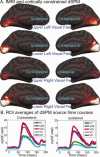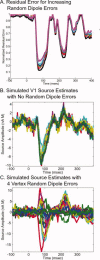Source estimates for MEG/EEG visual evoked responses constrained by multiple, retinotopically-mapped stimulus locations
- PMID: 18570197
- PMCID: PMC2754810
- DOI: 10.1002/hbm.20597
Source estimates for MEG/EEG visual evoked responses constrained by multiple, retinotopically-mapped stimulus locations
Abstract
Studying the human visual system with high temporal resolution is a significant challenge due to the limitations of the available, noninvasive measurement tools. MEG and EEG provide the millisecond temporal resolution necessary for answering questions about intracortical communication involved in visual processing, but source estimation is ill-posed and unreliable when multiple; simultaneously active areas are located close together. To address this problem, we have developed a retinotopy-constrained source estimation method to calculate the time courses of activation in multiple visual areas. Source estimation was disambiguated by: (1) fixing MEG/EEG generator locations and orientations based on fMRI retinotopy and surface tessellations constructed from high-resolution MRI images; and (2) solving for many visual field locations simultaneously in MEG/EEG responses, assuming source current amplitudes to be constant or varying smoothly across the visual field. Because of these constraints on the solutions, estimated source waveforms become less sensitive to sensor noise or random errors in the specification of the retinotopic dipole models. We demonstrate the feasibility of this method and discuss future applications such as studying the timing of attentional modulation in individual visual areas.
2008 Wiley-Liss, Inc.
Figures










Similar articles
-
Improved method for retinotopy constrained source estimation of visual-evoked responses.Hum Brain Mapp. 2013 Mar;34(3):665-83. doi: 10.1002/hbm.21461. Epub 2011 Nov 18. Hum Brain Mapp. 2013. PMID: 22102418 Free PMC article.
-
Optimization of retinotopy constrained source estimation constrained by prior.Hum Brain Mapp. 2014 May;35(5):1815-33. doi: 10.1002/hbm.22293. Epub 2013 Jul 19. Hum Brain Mapp. 2014. PMID: 23868690 Free PMC article.
-
From evoked potentials to cortical currents: Resolving V1 and V2 components using retinotopy constrained source estimation without fMRI.Hum Brain Mapp. 2016 May;37(5):1696-709. doi: 10.1002/hbm.23128. Epub 2016 Feb 12. Hum Brain Mapp. 2016. PMID: 26870938 Free PMC article.
-
Human cortical areas underlying the perception of optic flow: brain imaging studies.Int Rev Neurobiol. 2000;44:269-92. doi: 10.1016/s0074-7742(08)60746-1. Int Rev Neurobiol. 2000. PMID: 10605650 Review.
-
Mapping function in the human brain with magnetoencephalography, anatomical magnetic resonance imaging, and functional magnetic resonance imaging.J Clin Neurophysiol. 1995 Sep;12(5):406-31. doi: 10.1097/00004691-199509010-00002. J Clin Neurophysiol. 1995. PMID: 8576388 Review.
Cited by
-
Disparity-tuned population responses from human visual cortex.J Neurosci. 2011 Jan 19;31(3):954-65. doi: 10.1523/JNEUROSCI.3795-10.2011. J Neurosci. 2011. PMID: 21248120 Free PMC article.
-
Learning to see words.Annu Rev Psychol. 2012;63:31-53. doi: 10.1146/annurev-psych-120710-100434. Epub 2011 Jul 29. Annu Rev Psychol. 2012. PMID: 21801018 Free PMC article. Review.
-
Localization of MEG human brain responses to retinotopic visual stimuli with contrasting source reconstruction approaches.Front Neurosci. 2014 May 27;8:127. doi: 10.3389/fnins.2014.00127. eCollection 2014. Front Neurosci. 2014. PMID: 24904268 Free PMC article.
-
V1 is not uniquely identified by polarity reversals of responses to upper and lower visual field stimuli.Neuroimage. 2010 Oct 1;52(4):1401-9. doi: 10.1016/j.neuroimage.2010.05.016. Epub 2010 May 20. Neuroimage. 2010. PMID: 20488247 Free PMC article.
-
Spatial specificity of alpha oscillations in the human visual system.Hum Brain Mapp. 2019 Oct 15;40(15):4432-4440. doi: 10.1002/hbm.24712. Epub 2019 Jul 10. Hum Brain Mapp. 2019. PMID: 31291043 Free PMC article.
References
-
- Ahlfors SP,Ilmoniemi RJ,Hamalainen MS ( 1992): Estimates of visually evoked cortical currents. Electroencephalogr Clin Neurophysiol 82: 225–236. - PubMed
-
- Aine CJ,Supek S,George JS,Ranken D,Lewine J,Sanders J,Best E,Tiee W,Flynn ER,Wood CC ( 1996): Retinotopic organization of human visual cortex: Departures from the classical model. Cereb Cortex 6: 354–361. - PubMed
-
- Aine C,Huang M,Stephen J,Christner R ( 2000): Multistart algorithms for MEG empirical data analysis reliably characterize locations and time courses of multiple sources. Neuroimage 12: 159–172. - PubMed
-
- Avidan G,Harel M,Hendler T,Ben‐Bashat D,Zohary E,Malach R ( 2002): Contrast sensitivity in human visual areas and its relationship to object recognition. J Neurophysiol 87: 3102–3116. - PubMed
-
- Barth DS,Di S ( 1991): Laminar excitability cycles in neocortex. J Neurophysiol 65: 891–898. - PubMed
MeSH terms
Substances
Grants and funding
LinkOut - more resources
Full Text Sources

